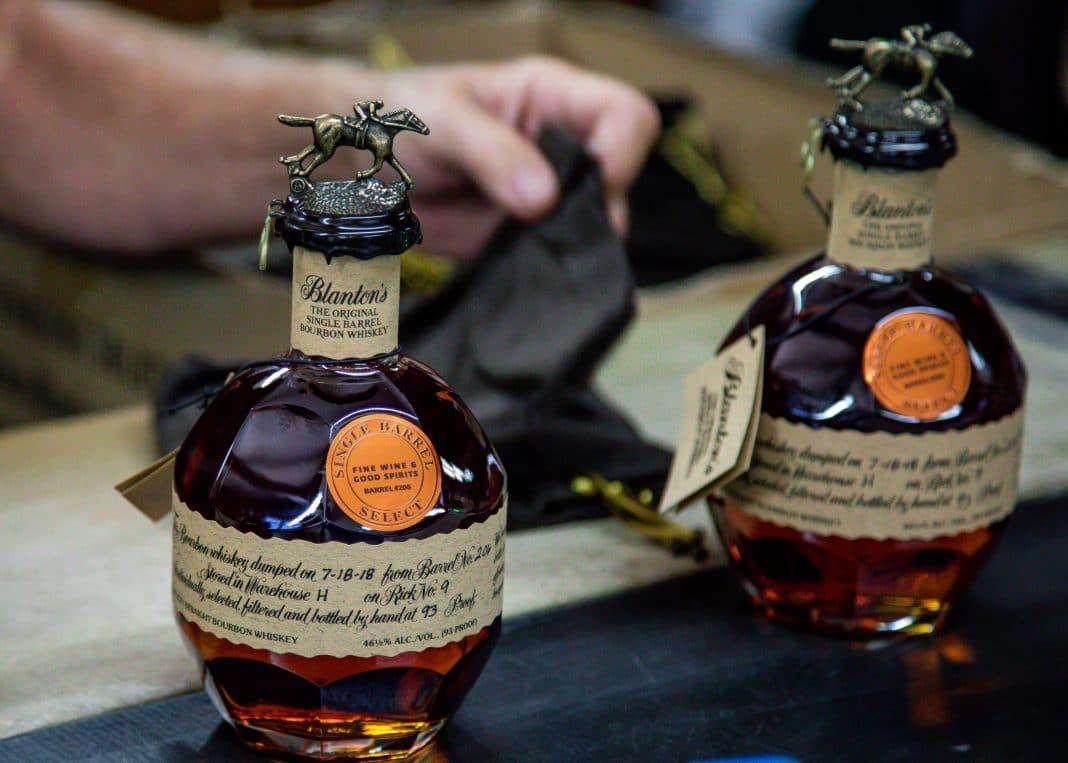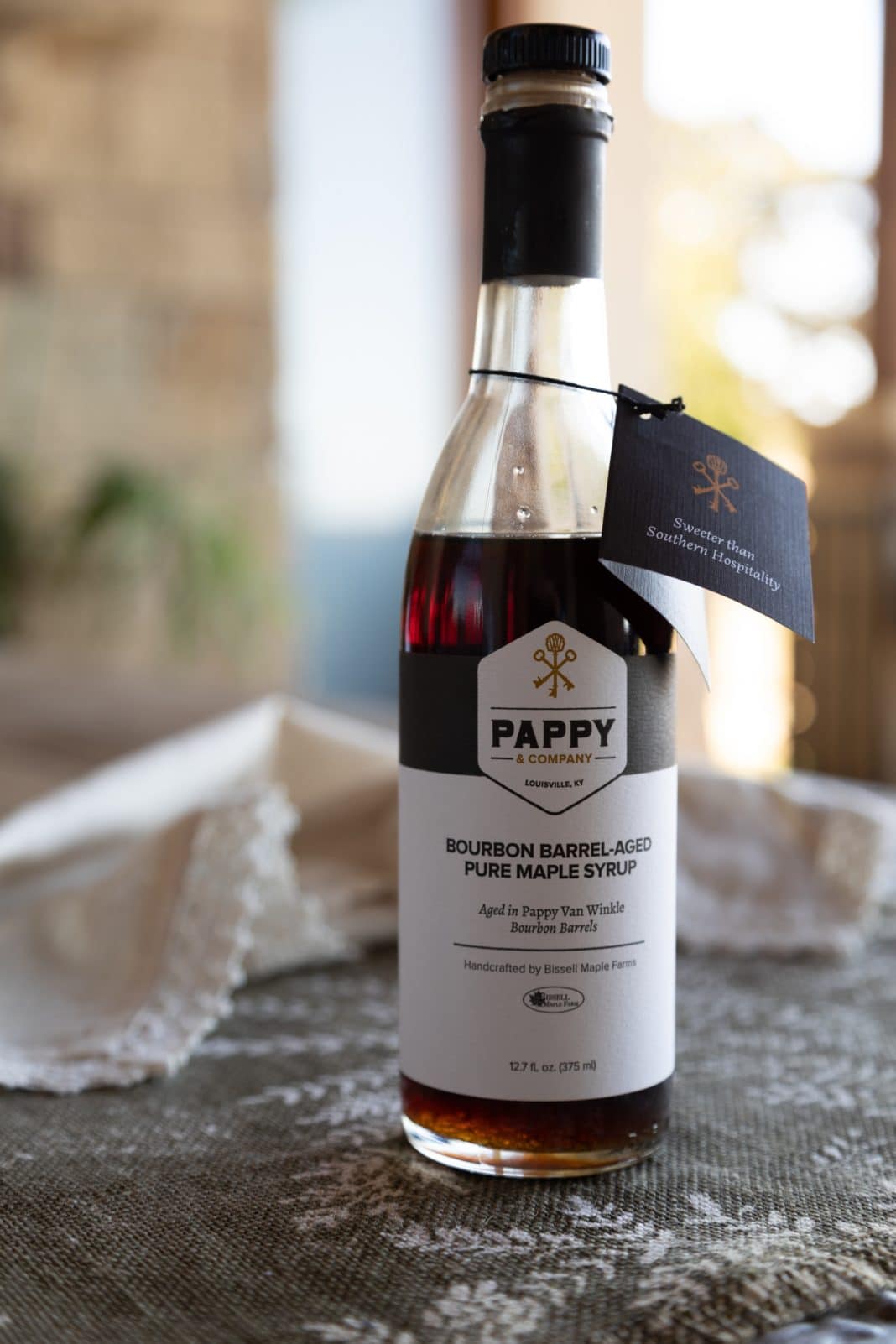Using America’s native spirit to sweeten your breakfast
Sitting on our back porch looking at the sherbet-colored sky above our Texas home a few nights ago, I was reminded of our family RV adventure along the Kentucky Bourbon and Tennessee Whiskey trails. The distillery tours we took were full of history, lore, incredible scents and science. A glass of bourbon holds a story; its complex, mysterious and one that has quietly developed for years as it slept quietly in its barrel waiting for that perfect moment to be awoken and poured into a bottle for you to enjoy. That moment when you take in all of its flavor, the mildly spicy yet sweet taste, helps you savor a mash-bill mix of 51% corn, rye and possibly malted barley. The new American oak charred barrel gives bourbon its vanilla, caramel and spice flavors.

All bourbon is whiskey, but not all whiskey is bourbon. Photo credit: Kate Dunbar
What separates American whiskey from bourbon? A strict set of standards from the government regulates and defines “America’s native spirit, bourbon,” and the guidelines are as follows: Bourbon is made in United States (not just Kentucky), produced from a fermented mash of 51% corn and distilled at no more than 160 proof. It’s stored at no more than 125 proof in new, charred American oak barrels, aged for minimum two years and free from additives or coloring.
I’ve been taking classes and attending tastings at many distilleries over the past two years. I’m friends with a Master Whisky taster who schools me regularly with facts, science and the magic of distilling bourbon. She goes into great detail about what’s happening to the barrel as it rests in certain areas of the rickhouse, the building barrels age in before being bottled. If a barrel is placed on a rack in the top levels of the rickhouse, the alcohol inside the barrel will evaporate much faster than it would if it rested towards the lower section of the rickhouse. All barrels along the east and west walls will age faster due to the sun rising and setting, which warms up those areas more than the north- or south-facing walls. The materials used in constructing these warehouses — like brick, wood, metal or even a dug-out limestone caves — all add to the flavor profile of bourbon.

Photo credit: Kate Dunbar
Let’s take another look at that upper level of the rickhouse. Because of hot air rising through the warehouse, the alcohol inside the barrel warms up and the wood of the barrel starts to absorb that alcohol at a much faster rate. This makes it easier for the alcohol to be pulled into the wood, where flavors and color develop quicker, resulting in a bourbon that can be bottled sooner because it is aged faster from the exposure to extreme weather conditions. When the winter season settles into the warehouse, that barrel wood contracts, expelling the alcohol from the wood back into the mix of the barrel. There you have the push and pull process of barrel aging.
One of my favorite moments when I visit a distillery is my first step into the rickhouse. I’m surrounded with the scents of smoke, spice, alcohol vapors and warm, thick air. If I’m visiting in the winter, it’s cold in the warehouse and the aroma is sharp, spicy and bold. The air is dry, the summer humidity and thick feeling has left and the dramatic climate change inside the building is about as breathtaking as anything I have ever experienced.

Photo credit: Kate Dunbar
Doing a Distillery Tour
Here are a few of my favorite distilleries to visit if you are traveling through Tennessee and Kentucky. First, you will need to start at the Tennessee Whiskey Trail and Kentucky’s Official Bourbon Trail. These two links will help you find the complete list of distilleries to visit, tools to help you plan your trip and a great spotlight on the master distillers.
Kentucky Distilleries
- Buffalo Trace Distillery, Franklin County, one of the original distilleries that was not closed during prohibition, this 200-year-old historic landmark has produced some of the world’s finest bourbon. In one year alone this distillery can produce 2.6 million gallons of whiskey.
- Jim Beam Distillery, Clermont, Kentucky seven generations and over 200 years in the Tennessee Whiskey craft, this distillery is cemented in family and the passed down generational education of its founders and employees.
- Limestone Branch Distillery, Lebanon, Kentucky two of the most famous bourbon labels have come from this distillery, Minor Case Bourbon and Yellowstone Bourbon. Steve and Paul Beam (yes that Beam family) proudly distill small batch Bourbon with a commitment to donate part of its proceeds to the National park Conservation Association.
Tennessee Distilleries
- Nelson’s Green Brier Distillery, Nashville, home of the Original Tennessee Whiskey.
- Old Dominick Distillery, Memphis. This distillery has a rich history and was groundbreaking in that they were the first to legally distill whiskey in Memphis since prohibition ended.
- George Dickel Tennessee Whisky, Tullahoma, has been producing some of the finest and smoothest whisky for over 60 years. Since its start this brand choose to keep with Scottish tradition by spelling whisky without an “e.”
- Jack Daniel Distillery, Lynchburg, with over 150 years of time-honored tradition. From burning and creating their own charcoal for the mellowing process to their legendary friendship with Frank Sinatra, this is a must-stop for all your whiskey wants and needs.
The Bourbon-Barbecue Connection
Where there’s good whiskey you can pretty much bet there is good BBQ nearby. That low-and-slow piece of pork seasoned with salt, pepper a few spices, then mopped with a mix of apple juice or apple cider and butter. Honestly, its delicious and if you can get to a good BBQ place in Kentucky, you will not be disappointed. Here are a few of my Bluegrass State picks:
- Moonlight Bar-B-Q Inn, Owensboro. Their hickory smoke makes their food taste unbelievable.
- Lyle’s BBQ Company, Lexington. Ask for the bacon and bourbon jam. I promise you will not be disappointed.
- Feast BBQ, Louisville, for the best pork ribs I’ve had outside of Memphis. The bourbon slushy is to die for.
- Old Hickory BBQ, Owensboro, has been tending their fire for over 100 years. Get the chopped pork with a side of spicy sauce. It will make your mouth tingle!
What better way to celebrate bourbon and pork than with a delicious and flavorful breakfast sausage? Homemade sausage patties are easy to make and cost a fraction of of what you pay for in store-bought prepackaged breakfast sausage. Use a few flavorful herbs and spices, fresh ground pork and the addition I have been waiting to use, Pappy & Co Bourbon Barrel-Aged Pure Maple Syrup. The maple syrup used was tapped from trees on the Bissell Maple Farm in Ohio.

Photo courtesy of Bissell maple farm
This family-run company not only grows the trees, but they tap the trees as well. Then they purchase used bourbon and rum barrels from distilleries and age their maple syrup in those rich flavored spirit-soaked wooden casks. Flavors of vanilla, oak, butter and, of course, bourbon shine through. This is one of my favorite toppings for homemade waffles or pancakes. Now to use it as an ingredient for my family to enjoy with our sausage-and-egg breakfast sandwiches.

Photo credit: Kate Dunbar
Bourbon Barrel-Aged Maple Syrup Sausage
2 pounds fresh-ground pork
¼ cup Pappy & Co. bourbon aged maple syrup
1 tablespoon fresh sage, chopped fine
1 tablespoon fresh thyme, chopped fine
1 teaspoon smoked paprika
1 teaspoon garlic powder
1 teaspoon red chili flake
2 teaspoons kosher salt
2 teaspoons ground black pepper
In a bowl add ground pork, garlic powder, smoked paprika, red chili flake, maple syrup, salt and pepper. Using your hands, mix the ingredients until all the spices are evenly distributed. To shape the sausage patties, divide sausage mixture into 2-ounce portions. Shape into balls and gently press the ball flat using the palms of your hands. Do not press the patties too flat or they crack around the edges. Place patties on a parchment-lined sheet pan and place in the refrigerator until ready to use.
Heat a nonstick or seasoned cast-iron pan over medium heat. Place four to six patties at a time to the hot pan. Cook for 5 minutes a side or until an instant-read thermometer registers 160 degrees and the center is not pink. Place on a paper towel-lined plate to absorb any extra fat and cover with foil to keep warm while you are cooking the remaining sausage patties.
Make ahead: The patties can be shaped and kept covered in the refrigerator for up to four days before cooking. To freeze the sausage patties, once you have pressed and shaped all the patties, place them on a parchment-lined baking sheet pan in one layer. Cover with plastic wrap and place in the freezer overnight until frozen solid, remove from baking sheet pan, and place in a zip top plastic bag. Return to freezer where they can stay for up to six months.
 Kate Dunbar has always had a passion for food. Growing up in a farming family, she took the statement “love your farmer” to heart. Now a published cookbook author, Kate has a mission is to show how delicious and simple outdoor cooking can be. Spending time at the campground started with her grandparents and now continues with her family as they travel all over the United States in search of food, fun and the joy of the open road.
Kate Dunbar has always had a passion for food. Growing up in a farming family, she took the statement “love your farmer” to heart. Now a published cookbook author, Kate has a mission is to show how delicious and simple outdoor cooking can be. Spending time at the campground started with her grandparents and now continues with her family as they travel all over the United States in search of food, fun and the joy of the open road.

